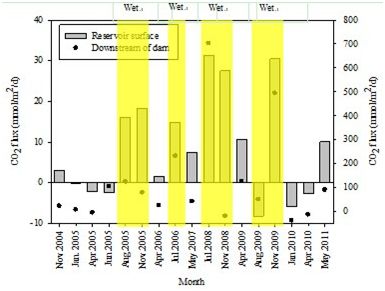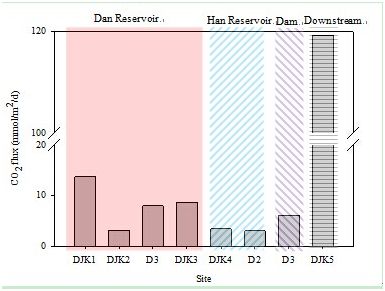Research Reveals Water-air Interface CO2 Emission in the Danjiangkou Reservoir
2014-08-27
Hydroelectric reservoirs have been increasingly concerned with respect to their contributions to greenhouse gas (GHG) emissions which are poorly understood due to data paucity particularly in monsoon region.
Danjiangkou Reservoir is situated in the Han River, which is one of the largest tributary of the Yangtze. The Reservoir is a major hydroelectric reservoir with typical geomorphological and hydro-climatological characteristics such as the location in a mountain area, subtropical monsoon climate and drastic shifts in seasonal drawdown zone. It could be representative of a typical case in the temperate zone where China's hydropower reservoirs are concentrated.
Dr. LI Siyue, supervised by Prof. ZHANG Quanfa from Wuhan Botanical Garden, examined the spatiotemporal changes of the carbonate system and CO2 flux of Danjiankou Reservoir in the subtropical monsoon climate region. A total of 21 field surveys conducted during 2004-2011 revealed significant spatial and monthly variations of aqueous partial pressure of CO2 (pCO2 ) in the Reservoir.
CO2 outgassing flux across the water-air interface in the Danjiangkou Reservoir was 1/13 lower than the flux from the river downstream the dam. Average CO2 flux and annual CO2 emission from the Reservoir were respectively 9 m mol m-2 d-1 and 3.4×109 mol Cy-1.
Seasonal hydrology exerted the first-order control on substantial monthly variations in pCO2 and CO2 flux, while biological CO2 uptake through aquatic photosynthesis dominated their spatial distributions in the Reservoir. The much higher CO2 flux in the river downstream the Reservoir was due to inherent water release for power generation. Correlative analyses demonstrated that pCO2 had strong positive correlations with Si and P speciations, TOC and DOC, negative correlations with DO saturation, TN and Chl-a.
Information in the spatial and temporal variability in CO2 flux from China’s hydroelectric reservoirs needs to be urgently included for revision of global models of reservoirs’ carbon emissions.
Results entitled “Partial pressure of CO2and CO2emission in a monsoon-driven


Monthly and spatial variations of CO2 diffusion fluxes in the Danjiangkou Reservoir, China (Image by Dr. LI Siyue)